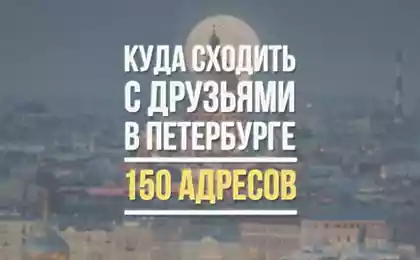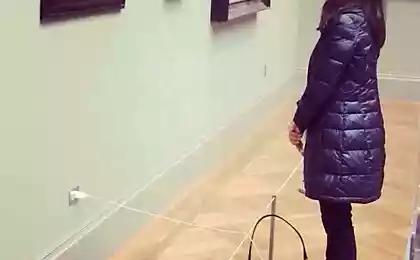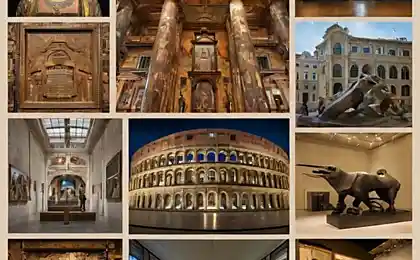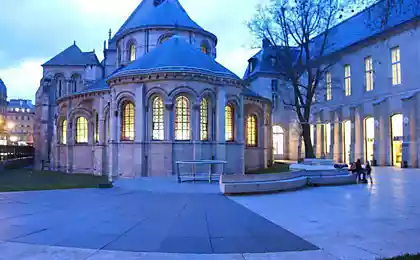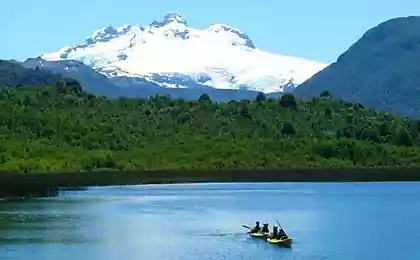846
Museum-Reserve "Breakthrough of the Siege of Leningrad"
Tanks "breakthrough", Diorama, Memorial «SV»
The museum-reserve includes many complexes and memorials, they are all very interesting, I was able to visit the museum "diorama break the blockade" and the memorial "Sinyavino Heights". Interesting is the exposition "Tanks breakthrough", which is located in front of the "Diorama", which of course is only a small part of the whole reserve. My Photo (67 photos), please do not criticize the text, too, so the same excerpts and illustrations from the book "Taki breakthrough", which tells about the exhibition and sale at the Museum (by SL Novichenko). If this dupe or format PL, remove the subject.

Operation "Iskra" is an important strategic breakthrough operation ended the blockade and restore land communications Leningrad. This operation is dedicated exhibition of the museum "Break the Siege of Leningrad" and the exposure tanks. Of the five tanks that are on display are directly involved in the operation alone. The remaining four tanks, were raised from the bottom of the Neva River and all of them took part in the battles for Leningrad.
Plan of Operation "Iskra»

Heavy Tank KV-1. The main tank defense of the city, was made at the Kirov factory and the factory immediately went into battle.
By the beginning of World War II, KV (Klim Voroshilov) was by far the most advanced in design and the most powerful in the world. None of the German anti-tank gun could not penetrate his armor. Before adopting a prototype tank participated in the Finnish campaign, which showed excellent results: accomplished the raid on the nearest enemy's rear and pulled in tow lined T-28. After the battle, the armor was found on the following nine hits 37mm caliber armor-piercing shells and no holes.

Tank KV-1 was raised from the bottom of the Neva River in April 2003. He sank on Nov. 5, 1941 during the shelling of the ferry. Memories BV Bichevskaya, Head of Engineering Management: & quot; the fire was so strong that fragments smote the ferry cable, but his springboard shell hit the ferry. Tank sank. & Quot;
We must pay tribute to the Soviet tank development, after sixty years spent at the bottom of the Neva River, running the tank was in good condition.

In its place in the exhibition tank followed its course.
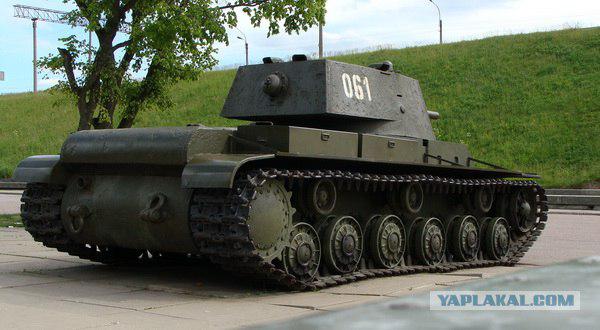
The machine gun of the KV-1

Track KV-1

TTX

Light infantry support tank T-26
Installed in the exhibition in January 2005, T-26, holds a special place in the history of Soviet tank. Hard to believe that such a "unprepossessing" vehicle was involved in fierce battles of World War II.

The first T-26 were two-tower armed with two machine guns 7 and 62 mm. Later, the tower on the right in place of the machine gun was mounted 37mm cannon "Hotchkiss". In 1933, production began odnobashennyh tanks, which in a rotating cylindrical tower was installed 45 mm cannon and coaxial machine gun DT. T-26 has played an important role in the Soviet tank building, it was a kind of laboratory where oprobyvat many of the technical ideas in the future to implement. He moved through the water by floats and even went to the bottom of the river. In 1932, on the basis of the T-26 was created the first serial flame tank OT-26 / CT-26.

The decision to restore the tank, or rather, what's left of it, it seemed to many controversial. Why expend so much energy on the warped "trough"?

All disputes ended when the car has taken its place in the exhibition (at the beginning of the layout of the tower) Small, with traces of wounds tank T-26, standing next to a formidable CV, its appearance suggests resilience and courage of the defenders of the city.

Traces shell hit in the T-26

T-38 amphibious tank.
In autumn 1942 the fighting resumed on the "Nevsky patch." On the night of September 26, 1942 tanks tanks again went to battle stations. It was a small T-38 from the separate battalion of light tanks.
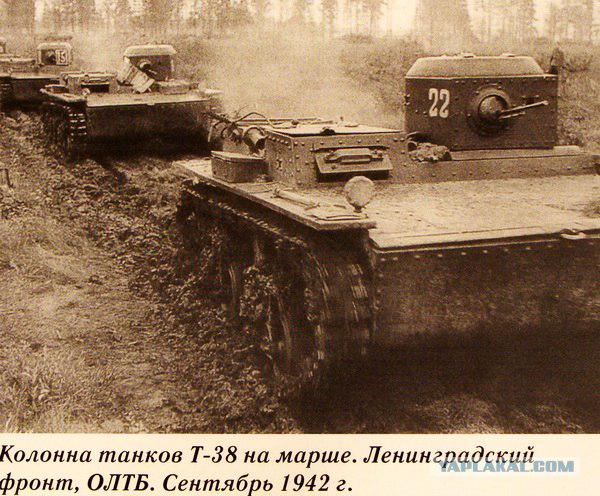
Ten tanks down to the water, but to the left bank rushed only seven, one of them broke down, the other two fell off the tracks, another ran into some underwater object sank. Noticing a crossing, the enemy opened heavy artillery, mortar fire and killed three more cars. On the left bank came just three tanks. During more chёtyrёh nights - sixteen. By October 6 of them survived only five.

T-38, raised from the Neva River in February 2005, was probably a party to the transaction. In the car was a box of hand grenades with the already inserted in them fuses and ammunition for machine gun DT - 16 full drive. By the nature of damage it can be assumed that the cause of the flooding became a projectile caught in the tower on a tangent.

Screw the T-38

Source:
The museum-reserve includes many complexes and memorials, they are all very interesting, I was able to visit the museum "diorama break the blockade" and the memorial "Sinyavino Heights". Interesting is the exposition "Tanks breakthrough", which is located in front of the "Diorama", which of course is only a small part of the whole reserve. My Photo (67 photos), please do not criticize the text, too, so the same excerpts and illustrations from the book "Taki breakthrough", which tells about the exhibition and sale at the Museum (by SL Novichenko). If this dupe or format PL, remove the subject.

Operation "Iskra" is an important strategic breakthrough operation ended the blockade and restore land communications Leningrad. This operation is dedicated exhibition of the museum "Break the Siege of Leningrad" and the exposure tanks. Of the five tanks that are on display are directly involved in the operation alone. The remaining four tanks, were raised from the bottom of the Neva River and all of them took part in the battles for Leningrad.
Plan of Operation "Iskra»

Heavy Tank KV-1. The main tank defense of the city, was made at the Kirov factory and the factory immediately went into battle.
By the beginning of World War II, KV (Klim Voroshilov) was by far the most advanced in design and the most powerful in the world. None of the German anti-tank gun could not penetrate his armor. Before adopting a prototype tank participated in the Finnish campaign, which showed excellent results: accomplished the raid on the nearest enemy's rear and pulled in tow lined T-28. After the battle, the armor was found on the following nine hits 37mm caliber armor-piercing shells and no holes.

Tank KV-1 was raised from the bottom of the Neva River in April 2003. He sank on Nov. 5, 1941 during the shelling of the ferry. Memories BV Bichevskaya, Head of Engineering Management: & quot; the fire was so strong that fragments smote the ferry cable, but his springboard shell hit the ferry. Tank sank. & Quot;
We must pay tribute to the Soviet tank development, after sixty years spent at the bottom of the Neva River, running the tank was in good condition.

In its place in the exhibition tank followed its course.

The machine gun of the KV-1

Track KV-1

TTX

Light infantry support tank T-26
Installed in the exhibition in January 2005, T-26, holds a special place in the history of Soviet tank. Hard to believe that such a "unprepossessing" vehicle was involved in fierce battles of World War II.

The first T-26 were two-tower armed with two machine guns 7 and 62 mm. Later, the tower on the right in place of the machine gun was mounted 37mm cannon "Hotchkiss". In 1933, production began odnobashennyh tanks, which in a rotating cylindrical tower was installed 45 mm cannon and coaxial machine gun DT. T-26 has played an important role in the Soviet tank building, it was a kind of laboratory where oprobyvat many of the technical ideas in the future to implement. He moved through the water by floats and even went to the bottom of the river. In 1932, on the basis of the T-26 was created the first serial flame tank OT-26 / CT-26.

The decision to restore the tank, or rather, what's left of it, it seemed to many controversial. Why expend so much energy on the warped "trough"?

All disputes ended when the car has taken its place in the exhibition (at the beginning of the layout of the tower) Small, with traces of wounds tank T-26, standing next to a formidable CV, its appearance suggests resilience and courage of the defenders of the city.

Traces shell hit in the T-26

T-38 amphibious tank.
In autumn 1942 the fighting resumed on the "Nevsky patch." On the night of September 26, 1942 tanks tanks again went to battle stations. It was a small T-38 from the separate battalion of light tanks.

Ten tanks down to the water, but to the left bank rushed only seven, one of them broke down, the other two fell off the tracks, another ran into some underwater object sank. Noticing a crossing, the enemy opened heavy artillery, mortar fire and killed three more cars. On the left bank came just three tanks. During more chёtyrёh nights - sixteen. By October 6 of them survived only five.

T-38, raised from the Neva River in February 2005, was probably a party to the transaction. In the car was a box of hand grenades with the already inserted in them fuses and ammunition for machine gun DT - 16 full drive. By the nature of damage it can be assumed that the cause of the flooding became a projectile caught in the tower on a tangent.

Screw the T-38

Source:
